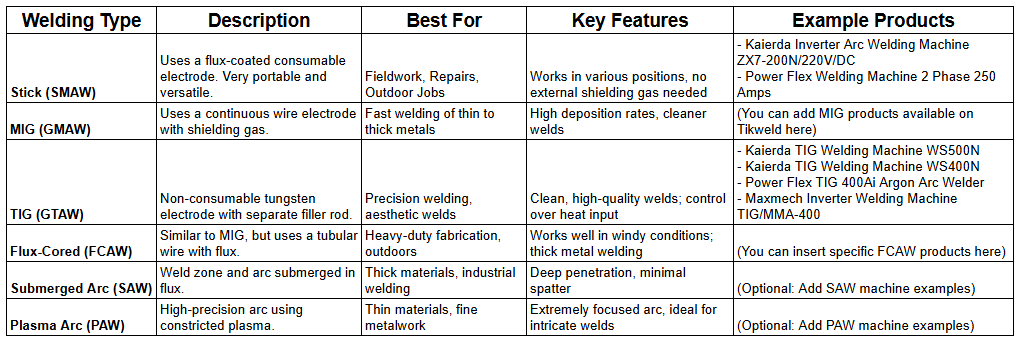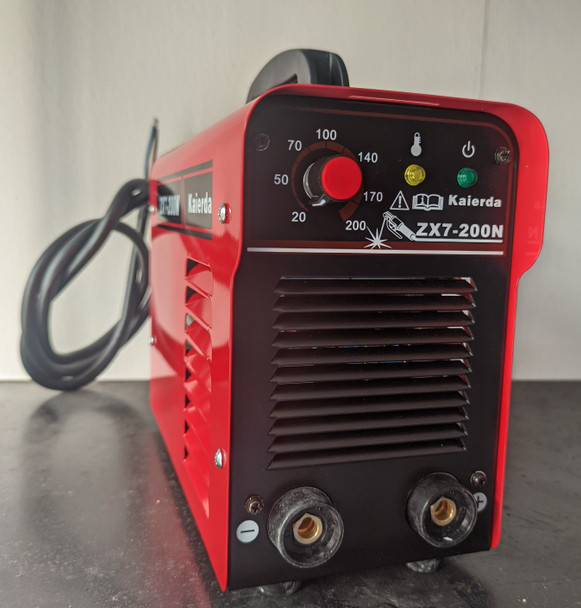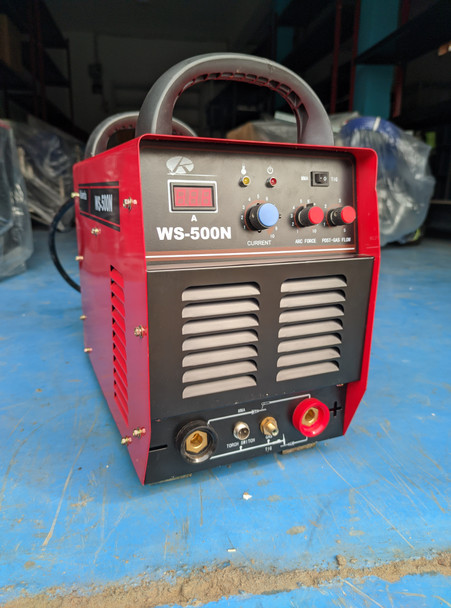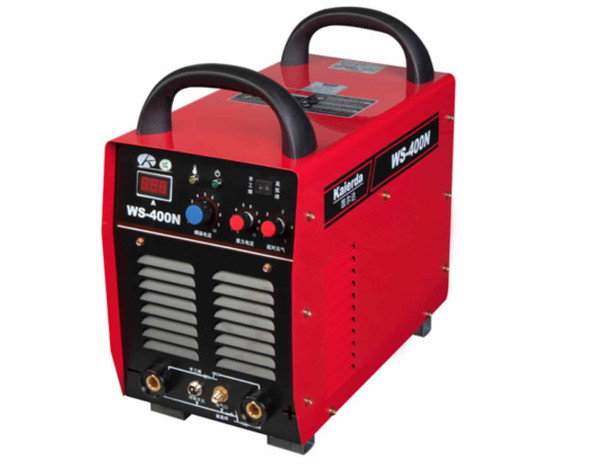The Ultimate Guide to Arc Welding Machines: Types, Features, and Applications
Introduction
Arc welding machines are the heartbeat of many industries, from construction and manufacturing to the creation of artistic masterpieces. The significance of comprehending these machines and their capabilities cannot be overstated. With the right knowledge, you'll not only master the art of welding but also unlock a world of opportunities and applications.
Kaierda Inverter/Arc Welding machine ZX7-200N/220V/DC
Key Takeaway
- Arc welding machines are vital tools used across various industries for joining metal components.
- There are different types, including Stick (SMAW), MIG (GMAW), TIG (GTAW), and Flux-Cored (FCAW) welders—each suited for specific applications and materials.
- Choosing the right type depends on factors like metal thickness, work environment, and desired weld quality.
- Key features to consider include duty cycle, power source compatibility, portability, and ease of use.
Read more...Argon Gas Welding: Creating Strong and Durable Welds
Understanding Arc Welding Machines: Types, Functions, and Practical Uses for Every Welder
Arc welding machines are essential tools for joining metals through the application of heat and creating a strong weld. They come in several types, each designed for specific applications and welding requirements. The Stick Welding Machines (SMAW) are versatile and portable, making them ideal for fieldwork and repairs. They use a consumable electrode with a flux coating, making them suitable for various materials and positions. MIG Welding Machines on the otherhand (GMAW) employ a continuous, solid wire electrode and a shielding gas. They offer high deposition rates and are well-suited for fast welding. Commonly used for steel, aluminum, and stainless steel, MIG welding is versatile and can handle both thin and thick materials. While TIG Welding Machines (GTAW) are known for their precision and control. They utilize a non-consumable tungsten electrode and a separate filler material, making them perfect for welding exotic materials and applications where high-quality, aesthetic welds are essential.
Each of these arc welding machine types has unique characteristics, making them suitable for specific tasks, materials, and working conditions. Welders must understand and choose the right arc welding machine to achieve the best results in their welding projects. Read on to learn more about the other types.
Throughout this guide, we will navigate through the depths of arc welding, dissecting the various machine types, exploring their features, and uncovering the boundless applications that make them the backbone of multiple industries. From shaping skyscrapers to crafting sculptures, arc welding is the alchemy that turns raw materials into works of art and engineering marvels.
So, join us on this illuminating journey, as we unravel the secrets of arc welding machines and equip you with the knowledge needed to excel in this dynamic world of welding. Whether you seek a comprehensive understanding of these machines, wish to refine your welding techniques, or aspire to explore the myriad applications they serve, this guide has it all. Let's dive into the sparks, steel, and skill that make arc welding an art and science worth mastering.
Read more...Revolutionizing Industrial Processes with Arc Welding Machines: A Comprehensive Guide
Types of Arc Welding Machines
Arc welding machines play a pivotal role in the welding industry, offering a versatile range of options tailored to specific welding needs. Understanding the different types of arc welding machines is crucial for welders to choose the most suitable one for their projects. In this article, we will explore the primary types of arc welding machines and discuss their key features and applications.
Stick Welding Machines (SMAW - Shielded Metal Arc Welding)
Also known as manual metal arc welding or "stick" welding, SMAW is one of the most widely used arc welding processes. This method involves using a consumable electrode coated with a flux material. Stick welding is highly versatile and can be employed in various positions, making it a preferred choice for many fieldwork and repair applications.
MIG Welding Machines (GMAW - Gas Metal Arc Welding)
MIG welding machines are characterized by their use of a continuous solid wire electrode and a shielding gas, often argon or a mixture of gases. This process is renowned for its high deposition rates, making it ideal for fast welding. MIG welding is commonly used for welding steel, aluminum, and stainless steel, and it can be adapted for both thin and thick materials.
Welding Machines (GTAW - Gas Tungsten Arc Welding)
TIG welding machines are celebrated for their precision and control. This process employs a non-consumable tungsten electrode and a separate filler material, if necessary. TIG welding is highly regarded for producing high-quality welds and is commonly used in industries where precision is critical, such as aerospace and artistic applications.
Flux-Cored Arc Welding Machines (FCAW)
Flux-cored arc welding combines elements of both MIG and stick welding. It utilizes a tubular wire electrode filled with a flux core. This approach is well-suited for welding thicker materials and excels in adverse conditions due to its self-shielding flux, making it a preferred choice for shipbuilding and construction.
Submerged Arc Welding Machines (SAW)
Submerged arc welding is an incredibly efficient process used for welding thick materials, particularly in large-scale industrial applications. It involves submerging both the arc and the weld zone beneath a granular flux, providing high deposition rates and excellent penetration.
Plasma Arc Welding Machines (PAW)
Plasma arc welding is similar to TIG welding but utilizes a constricted plasma arc. It offers exceptional precision and control, making it suitable for welding thin materials, fine wires, and applications that require intricate, detailed work.
Kaierda Tig Welding machine WS500N
Arc Welding Machine Comparison Table

Features and Components of Arc Welding Machines
Arc welding machines are highly versatile tools that come equipped with a range of features and components designed to meet the diverse needs of welders. Understanding these elements is crucial for welders to select the right machine for their specific applications. In this article, we'll explore the essential features and components of arc welding machines.
Power Sources
Power sources are the heart of any arc welding machine, as they provide the necessary electrical energy to generate the welding arc. There are two primary types of power sources:
- Constant Current (CC): These power sources maintain a consistent current output, which is typically used in processes like stick welding (SMAW) and TIG welding (GTAW). They are well-suited for welding applications with varying arc lengths.
- Constant Voltage (CV): These power sources maintain a stable voltage output and are often employed in MIG welding (GMAW) and flux-cored arc welding (FCAW). They offer more control over the weld pool and are ideal for applications where maintaining a consistent bead shape is crucial.
Controls and Settings
Arc welding machines come equipped with various controls and settings that allow welders to fine-tune their welding process. Some common controls include:
- Amperage Control: This setting regulates the welding current, affecting the heat input and the size of the weld bead.
- Voltage Control: Adjusting the voltage can influence the arc length, penetration, and the overall quality of the weld.
- Polarity Control: For processes like MIG welding, which may require reverse polarity (electrode positive) or straight polarity (electrode negative).
- Wire Feed Speed Control: Used in wire-fed welding processes, this control adjusts the speed at which the electrode or filler material is fed.
Electrode and Wire Feed Systems
The type of electrode or filler material used in arc welding machines can significantly impact the welding process. Common electrode and wire feed systems include:
- Consumable Electrodes: Used in processes like stick welding, MIG welding, and flux-cored arc welding, these electrodes provide the necessary filler material for the weld.
- Non-Consumable Electrodes: Tungsten electrodes are used in TIG welding, where a separate filler material may be added if needed.
- Wire Feed Systems: These are found in MIG and FCAW welding machines, feeding a continuous wire electrode through the welding torch to create the weld.
Cooling Systems
In many arc welding machines, cooling systems are essential to prevent overheating and ensure consistent performance. Water-cooled systems are common in high-amperage applications, while air-cooled systems are sufficient for lower amperage tasks. Efficient cooling systems help extend the life of the welding machine and maintain stable welding conditions.
Portability and Size
The portability and size of an arc welding machine can be critical factors, particularly for those who need to transport the equipment to different job sites. Smaller, lightweight machines are often favored for their ease of maneuverability, while larger machines with more power are suited for heavy-duty industrial applications.
Advanced Features and Innovations for Arc welding Machines
Modern arc welding machines often come with advanced features and innovations, such as:
- Digital Controls: Digital interfaces provide precise control over welding parameters and often include preset programs for various welding processes.
- Inverter Technology: Inverter-based machines are smaller, lighter, and more energy-efficient, making them a popular choice for many welders.
- Synergic Control: Synergic machines automatically adjust welding parameters based on the selected settings, simplifying the welding process for beginners.
- Pulse Welding: Pulse welding allows for better control of the heat input, making it suitable for welding thin materials and achieving a clean, aesthetically pleasing weld.
Accessories and Add-Ons
Welders can enhance their arc welding machines with various accessories and add-ons, such as:
- Welding Helmets and Safety Gear: Essential for protecting the welder's eyes and body from harmful arc radiation and sparks.
- Welding Carts and Tables: These aid in the transportation and organization of welding equipment and materials.
- Consumables: Welding consumables include electrodes, wires, and shielding gases tailored to the specific welding process.
- Fume Extraction Systems: Important for removing welding fumes and maintaining a safe working environment.
- Remote Controls: These allow welders to adjust settings at a distance, improving convenience and efficiency.
Applications of Arc Welding Machines
Arc welding machines, renowned for their versatility, are indispensable tools across a multitude of industries. From towering skyscrapers to intricate artistic creations, these machines play a pivotal role in shaping our world. In this article, we will explore the diverse applications of arc welding machines, spanning a broad spectrum of fields.
Automotive and Transportation
The automotive and transportation industry heavily relies on arc welding machines for the assembly and repair of vehicles. These machines are used to join chassis components, engine parts, exhaust systems, and even body panels. Whether it's the construction of a heavy-duty truck or the precise welding of a race car frame, arc welding ensures structural integrity and safety in the automotive world.
Construction and Infrastructure
In the construction and infrastructure sector, arc welding machines are vital for joining steel and other structural materials. Skyscrapers, bridges, and tunnels all owe their strength and durability to the welds created by these machines. Whether it's welding massive I-beams or reinforcing a building's frame, arc welding is an essential construction tool.
Manufacturing and Fabrication
Manufacturing and fabrication industries are among the heaviest users of arc welding machines. These machines play a pivotal role in producing machinery, equipment, and consumer goods. Manufacturing processes like metal fabrication, where raw materials are transformed into finished products, rely on various arc welding techniques to create durable and dependable connections.
Aerospace and Defense
The aerospace and defense industries demand exceptional precision and reliability, making arc welding an ideal choice for their applications. These machines are used in crafting aircraft frames, rocket components, and military vehicles. The quality of the welds is of utmost importance in these applications to ensure safety and performance under extreme conditions.
Arts and Crafts
Arc welding isn't limited to industrial and heavy-duty applications. It has also found its place in the world of art and craftsmanship. Welded sculptures, metal artwork, and decorative items are created using the intricate control that arc welding machines offer. The ability to fuse metals with precision allows artists to express their creativity and craft unique pieces.
DIY and Home Welding Projects
Arc welding machines are not exclusive to professionals; they have also made their way into the realm of DIY and home projects. Enthusiasts and hobbyists use these machines for a variety of tasks, from repairing household items to creating custom furniture or garden structures. The versatility of these machines allows individuals to tackle a wide range of projects and explore their welding skills.
In conclusion, arc welding machines are versatile tools that transcend the boundaries of industries and applications. Their ability to create strong, reliable welds in a variety of materials makes them essential in fields ranging from automotive and construction to aerospace, art, and even DIY projects. These machines are the driving force behind innovation, structural integrity, and artistic expression across a multitude of sectors.
Tips on How to Use Arc Welding Machines Safely
Arc welding is a powerful and versatile process, but it can also be hazardous if not handled with care. Ensuring safety during welding is paramount. In this article, we will explore essential tips for using arc welding machines safely, from understanding safety basics to maintaining your equipment and addressing common issues.
Know Your Machine:
Familiarize yourself with the specific arc welding machine you are using. Read the manufacturer's instructions and understand its operation and safety features.
Eye Protection:
Always wear appropriate eye protection, such as a welding helmet with a darkened lens, to shield your eyes from harmful arc radiation and intense light.
Skin Protection:
Wear flame-resistant clothing, including a welding jacket, gloves, and pants, to protect your skin from sparks, heat, and UV radiation.
Footwear:
Choose high-top leather boots to shield your feet from falling debris and hot metal. Steel-toed boots are preferable for added protection.
Safety Check:
Ensure that the welding area is clear of flammable materials, and be aware of the location of fire extinguishers and first aid supplies.
Fire Safety:
Have a fire-resistant welding blanket or shield on hand to protect nearby combustible materials from sparks and slag.
Grounding:
Properly ground your welding machine and workpiece to prevent electrical shock and ensure the safety of your electrical circuits.
Kaierda Tig Welding machine WS400N
Personal Protective Equipment (PPE)
Wearing the right personal protective equipment (PPE) is crucial for safeguarding yourself while using an arc welding machine:
Welding Helmet:
Choose a quality welding helmet with a darkened auto-darkening lens that instantly adjusts to the arc's brightness.
Welding Gloves:
Invest in heat-resistant welding gloves to protect your hands from burns and sparks.
Welding Jacket and Pants:
Flame-resistant clothing is essential to shield your skin from the heat and sparks produced during welding.
Respiratory Protection:
In situations where fumes and gases are a concern, use a respirator or welding fume extractor to prevent inhalation of harmful substances.
Proper Ventilation and Workspace
A well-ventilated workspace is crucial to maintaining good air quality while welding:
Ventilation:
Ensure your workspace has adequate natural or mechanical ventilation to disperse welding fumes and gases.
Welding Curtains:
Use welding curtains or screens to separate your welding area from other parts of the workspace, protecting nearby individuals from harmful radiation and sparks.
Fire Safety:
Always have fire extinguishers readily available in case of a fire emergency.
Common Welding Hazards and How to Avoid Them
Welding Fumes:
Welding produces hazardous fumes, which can lead to respiratory problems. Avoid welding in enclosed spaces without proper ventilation and use respiratory protection when needed.
Electric Shock:
Arc welding machines carry high electrical currents. Ensure the machine is grounded, check cables for damage, and never touch the electrode or workpiece with bare skin.
Eye Injuries:
Welding arcs emit intense light that can cause eye damage. Always wear a welding helmet with a darkened lens.
Burns and Skin Injuries:
Wear appropriate PPE, such as gloves and clothing, to protect your skin from burns and sparks. Avoid welding on surfaces with oil, grease, or water that can cause splatter.
Maintenance and Troubleshooting
To ensure the safety and efficiency of your arc welding machine, regular maintenance and addressing common issues are essential:
Basic Maintenance Tips:
Clean and inspect your machine regularly, ensuring cables and connections are in good condition, and lubricate moving parts as needed.
Troubleshooting Common Issues:
Be prepared to troubleshoot common welding issues like poor weld quality, unstable arcs, or electrical problems by consulting your machine's manual and seeking advice from professionals or online resources.
When to Seek Professional Repairs:
If you encounter a technical issue beyond your expertise, consult a qualified technician or service center to avoid potential hazards and ensure the machine's safety and performance.
Frequently Asked Questions
1. How does an arc welding machine work?
Arc welding machines create an electric arc by passing electrical current through an electrode, which generates intense heat. This heat melts the electrode and the workpiece, allowing them to fuse together.
2. What types of metals can be welded using arc welding machines?
Arc welding machines can be used to weld a wide range of metals, including steel, stainless steel, aluminium, copper, and various alloys.
3. How do I choose the right arc welding machine for my needs?
Consider factors such as the type of welding you'll be doing, the materials you'll be working with, your budget, and the available power source (e.g., 110V or 220V). Consulting with a welding professional or instructor can be helpful in making the right choice.
Related Articles.
How to Choose the Best Arc Welding Machine
An Overview of Different Types of Arc Welding Machines
10 Tips on Simple Ways to Keep Your Power Tools in Good Working Order
Conclusion
Arc welding machines are indispensable tools in countless industries, offering strength, precision, and versatility for a wide range of metalworking applications. From the rugged efficiency of Stick welders to the precision of TIG and the speed of MIG, understanding the different types and their uses empowers professionals and hobbyists alike to make informed decisions for their welding needs.
Whether you’re taking on structural fabrication, automotive repair, or artistic metalwork, having the right welding machine is key to achieving quality, durability, and safety in every project.
At Tikweld Welding Supplies and Services, we offer a curated selection of high-performance arc welding machines from trusted brands, designed to meet the demands of professionals and enthusiasts across Nigeria and beyond.









